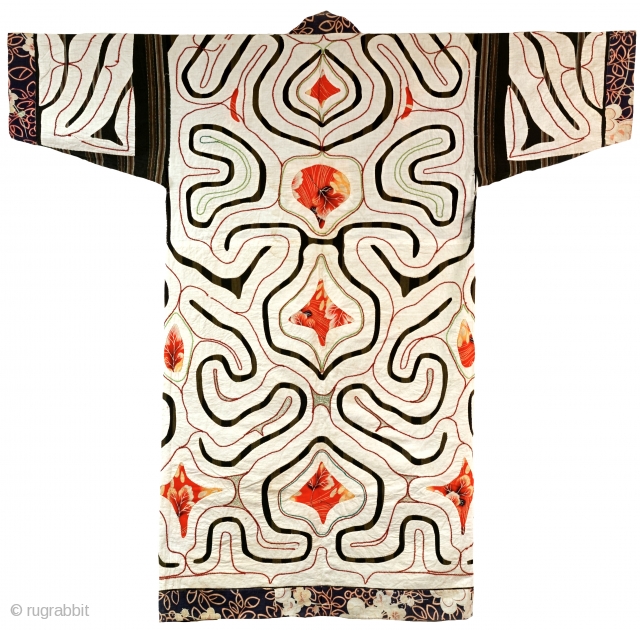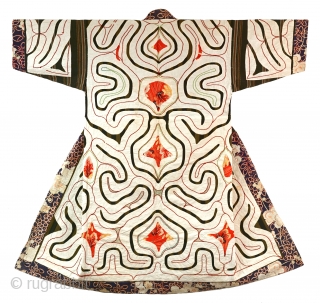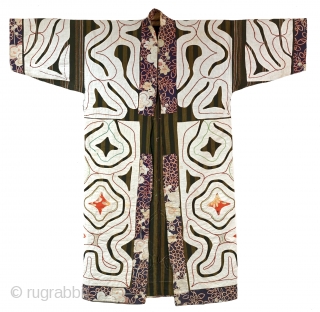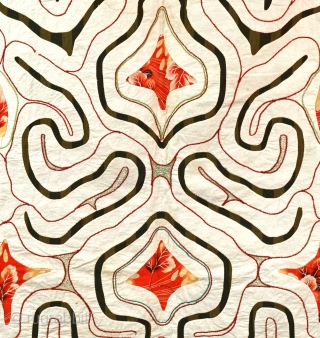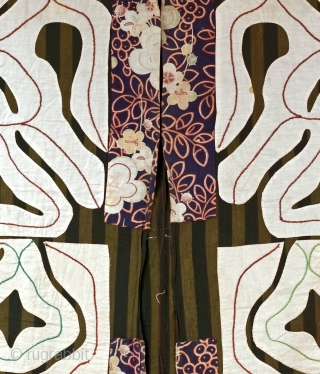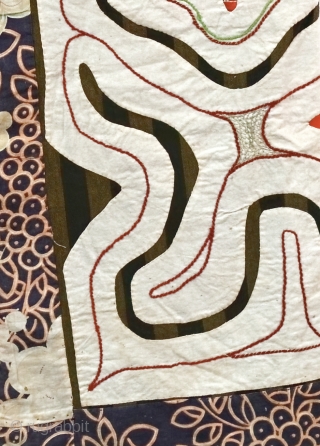Back
Ainu Robe - Ceremonial Kaparamip Kimono
The Ainu people traditionally used elm-bark to weave garments and accessories. By the late nineteenth century, trade between the Ainu and the mainland Japanese proliferated, increasing the availability of cotton on the Ainu lands.
Kaparamip means "thin clothes" and the category refers to the lightweight robes made of trade cotton and is characterized by large portions of white cotton appliqué laid over a darker-colored base fabric.
This particular garment originated in the Hidaka region of southern Hokkaido. The base cloth of the body is a handsome brown shima, or stripe, cotton. Printed commercial cottons of red florals were added as central accents. Next an overall white cotton applique was laid on top and everything was finished with chain stitched embroidery using green and red thread. The borders incorporate a contrasting purple printed floral pattern on commercial cotton.
The robe was purchased directly from an Ainu family. The kimono was finished by the great-grandmother of the previous owner. It was worn at summer festivals and ceremonies. There are light discolorations to some of the applique that i have not attempted to remove. Some light areas of fraying, though no tears or rips.
Early 1900's (Taisho era)
Dimensions: Length: 50"; Width: 46"
price:
POR
- Home
- Antique Rugs by Region
- Category
- Profiles
- Post Items Free
- Albums
- Benaki Museum of Islamic Art
- Budapest: Ottoman Carpets
- Gulbenkian Museum
- Islamic Carpets. Brooklyn
- Islamic Textiles. Brooklyn
- Konya Museum: Rugs
- MKG, Hamburg
- MMA: Caucasian Carpets
- MMA: Mamluk Carpets
- MMA: Mughal Indian Carpets
- MMA: Ottoman Carpets
- MMA: Safavid Persian Carpets
- MMA: Turkmen Rugs
- McCoy Jones Kilims
- Ottoman textiles. Met
- Philadelphia Museum
- Rugs and Carpets: Berlin
- Seljuqs at the Met
- TIEM, Istanbul: Carpets
- V&A: Classical Carpets
- Vakiflar Carpets: Istanbul
- Baluch Rugs: Indianapolis
- Gallery Exhibitions
- Jaf an Exhibition
- Alberto Levi Gallery
- Andean Textile
- Christie's London: 2016
- Francesca Galloway
- HALI at 40
- ICOC Washington, DC 2018
- Jajims of the Shahsavan
- London Islamic Week April, 2018
- Mongolian Felts
- Navajo Rugs: JB Moore
- Persian Piled Weavings
- SF Tribal & Textile Art Show 2020
- SF Tribal 2019
- Sotheby's: C. Alexander
- Turkish Prayer Rugs
- Turkmen Main Carpets ICOC 2007







